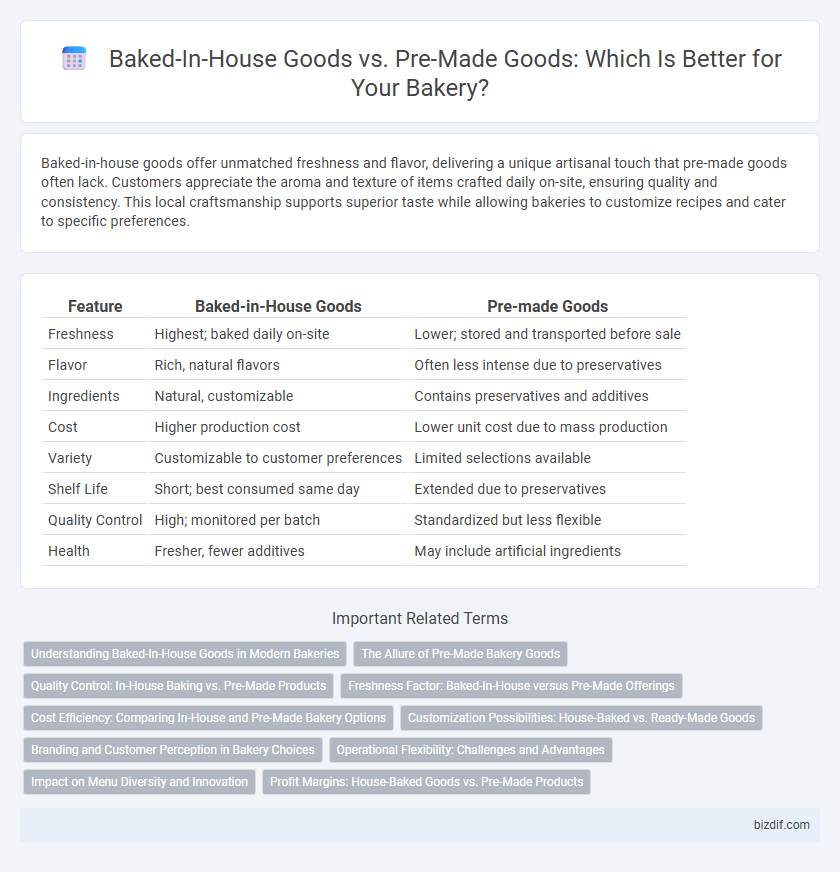Baked-in-house goods offer unmatched freshness and flavor, delivering a unique artisanal touch that pre-made goods often lack. Customers appreciate the aroma and texture of items crafted daily on-site, ensuring quality and consistency. This local craftsmanship supports superior taste while allowing bakeries to customize recipes and cater to specific preferences.
Table of Comparison
| Feature | Baked-in-House Goods | Pre-made Goods |
|---|---|---|
| Freshness | Highest; baked daily on-site | Lower; stored and transported before sale |
| Flavor | Rich, natural flavors | Often less intense due to preservatives |
| Ingredients | Natural, customizable | Contains preservatives and additives |
| Cost | Higher production cost | Lower unit cost due to mass production |
| Variety | Customizable to customer preferences | Limited selections available |
| Shelf Life | Short; best consumed same day | Extended due to preservatives |
| Quality Control | High; monitored per batch | Standardized but less flexible |
| Health | Fresher, fewer additives | May include artificial ingredients |
Understanding Baked-In-House Goods in Modern Bakeries
Baked-in-house goods in modern bakeries offer superior freshness, flavor, and customization compared to pre-made goods, as they are crafted from raw ingredients on-site daily. These products often feature unique recipes and artisan techniques that enhance texture and taste, meeting consumer demand for authenticity and quality. Emphasizing in-house baking supports local sourcing and reduces reliance on mass-produced items, contributing to sustainability and distinct brand identity.
The Allure of Pre-Made Bakery Goods
Pre-made bakery goods offer consistent quality and time-saving convenience, making them a popular choice for busy consumers and businesses alike. These products often come from large-scale producers with advanced baking technology, ensuring uniform texture and flavor across batches. The extended shelf life and lower cost of pre-made goods attract both retailers and shoppers seeking reliable and affordable options.
Quality Control: In-House Baking vs. Pre-Made Products
In-house baked goods allow bakeries to maintain strict quality control over ingredient freshness, baking times, and consistency, ensuring superior taste and texture. Pre-made products often sacrifice control due to mass production and extended shelf life requirements, leading to variability in quality. Controlling every step from dough preparation to final baking enhances product reliability and customer satisfaction.
Freshness Factor: Baked-In-House versus Pre-Made Offerings
Baked-in-house goods prioritize freshness by being prepared daily on-site, ensuring optimal flavor and texture that pre-made goods often lack due to packaging and extended shelf life. The freshness factor significantly impacts customer satisfaction, with house-baked items exhibiting superior aroma, moisture retention, and crumb quality. Retail bakeries emphasize baked-in-house products to differentiate from mass-produced alternatives, leveraging this freshness as a key selling point.
Cost Efficiency: Comparing In-House and Pre-Made Bakery Options
In-house baked goods often have higher upfront costs due to ingredient sourcing and labor but offer greater control over quality and customization, leading to better long-term brand value. Pre-made bakery goods usually have lower immediate expenses and reduced labor requirements, making them cost-efficient for high-volume or budget-conscious operations. Evaluating cost efficiency between these options depends on factors like production volume, ingredient cost, labor rates, and desired product differentiation.
Customization Possibilities: House-Baked vs. Ready-Made Goods
House-baked goods offer extensive customization possibilities, allowing bakers to tailor recipes, flavors, and ingredients to meet specific customer preferences and dietary needs. Pre-made goods typically come with fixed recipes and limited options for modification, restricting personalization. Customization in house-baked items enhances freshness, uniqueness, and customer satisfaction in bakery products.
Branding and Customer Perception in Bakery Choices
Baked-in-house goods enhance bakery branding by emphasizing freshness, authenticity, and artisanal quality, fostering stronger customer trust and loyalty. Consumers often perceive in-house baked items as superior in taste and craftsmanship compared to pre-made goods, associating them with a genuine bakery experience. This perception drives repeat purchases and positive word-of-mouth, reinforcing the bakery's market position and differentiation.
Operational Flexibility: Challenges and Advantages
Baked-in-house goods offer greater operational flexibility by allowing bakeries to adjust recipes and production schedules in real-time based on customer demand and ingredient availability. Pre-made goods reduce preparation time and labor costs, but they limit customization and responsiveness to changes in product trends or supply chain disruptions. Balancing in-house baking with pre-made inventory can optimize operational efficiency while maintaining product freshness and variety.
Impact on Menu Diversity and Innovation
Baked-in-house goods significantly enhance menu diversity by allowing bakers to experiment with unique recipes and seasonal ingredients, fostering continuous innovation. In contrast, pre-made goods often limit customization and creativity due to standardization and supplier constraints. Emphasizing freshly baked products supports a dynamic menu that attracts customers seeking distinctive flavors and artisanal quality.
Profit Margins: House-Baked Goods vs. Pre-Made Products
House-baked goods typically yield higher profit margins due to lower ingredient costs and the ability to control quality, attracting premium pricing. Pre-made products often involve markup from suppliers, reducing overall profitability despite saving on labor and time. Balancing the cost efficiency of pre-made items with the higher revenue from fresh, house-baked goods is crucial for maximizing bakery profits.
Baked-in-house goods vs Pre-made goods Infographic

 bizdif.com
bizdif.com